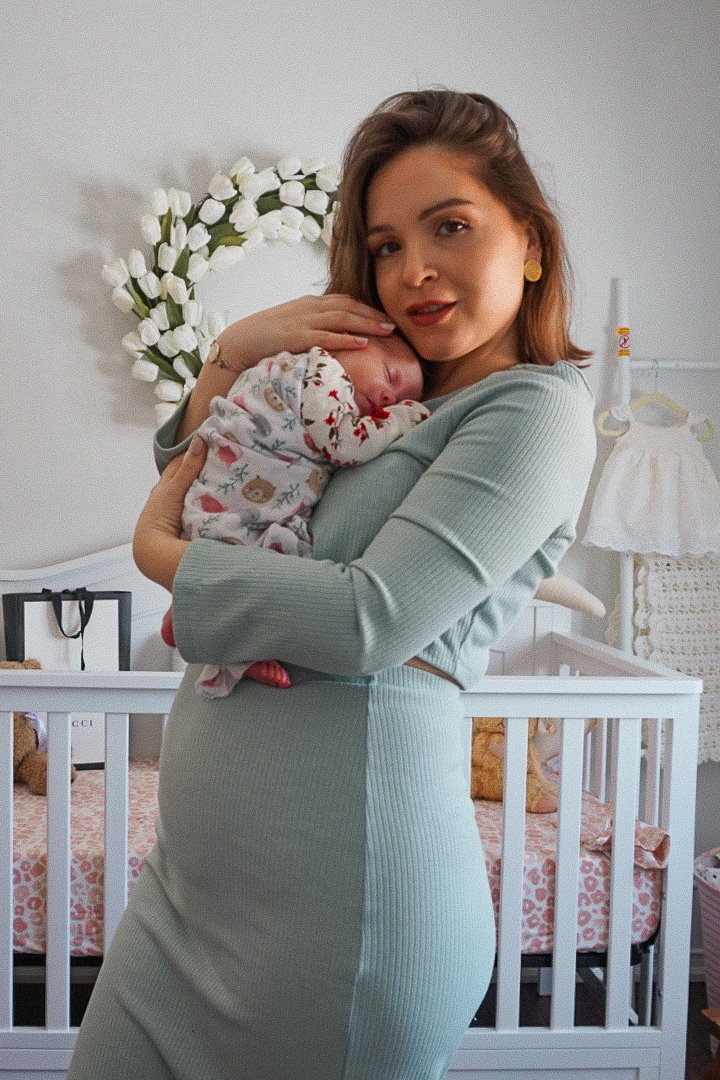Nothing Could Have Prepared Me For the Level Of Swelling That I Experienced…
When it comes to research, I thought I had studied all the possible scenarios for giving birth. Well, it turns out I missed a big one: many women’s bodies swell after giving birth. And if you’ve had a Caesarean, the swelling is notably worse. But even though I had read that some swelling is normal, nothing could have prepared me for the level of swelling that I experienced after my emergency c-section. It was truly horrifying! And I was scared that the swelling could become permanent, due to the rare condition called Lymphedema that I live with. (Lymphedema refers to an issue with the lymphatic system that causes chronic swelling and, eventually, disfigurement if left untreated.)
All women will experience some swelling after giving birth. So why is swelling more prominent if you’ve had a c-section versus a vaginal birth? It’s protocol to use an IV fluid drip during and following a Caesarean surgery. And this means your body has more fluid to flush.
Unfortunately for me, a nurse turned the dial up to max on my IV and a full bag of saline was pumped into my body over a one-hour period. The bag was meant to last me all night, so naturally, this was far too much fluid. Despite being released from the hospital early, the swelling I experienced from my waist down was extremely concerning. (Well, I was concerned. The nurses had no idea what Lymphedema was so they just shrugged and said ”yeah, that’s an abnormal amount of swelling… but just elevate your legs and it should be fine.”) Nope! I thought to myself, I’ve heard that before! I’ve followed that well-meaning but grossly misinformed advice before with regretful outcomes. If you also struggle with chronic swelling, you know what I mean.
Once I was back home, I immediately started looking into my options for reducing the swelling in my hips, legs, and ankles from the c-section surgery.
Here’s what worked for me and what I learned along the way. Though I have Lymphedema, these tips should be helpful for anyone struggling with excessive swelling after pregnancy.

M.L.D. (Manually Lymphatic Drainage) Massage
Manual lymphatic drainage should be done by a specialist, ideally. If you have health insurance, you should be able to apply your coverage for anyone with an RMT designation. While there has been an uptick over the past few years of masseuses claiming to know lymphatic drainage, you need to specifically look for a therapist with a M.L.D. (manual lymphatic drainage) designation or training. Extra points if they have Voder school training! (This is where many of the techniques for addressing chronic edema originated.) Most RMTs don’t receive complete M.L.D. training and often skip prepping your upper lymph nodes and also apply too much pressure.
Don’t know where to look to find a M.L.D. specialist? Try searching for the term ”lymphedema MLD therapist in _____” with the blank space being your city or location. You should get results near you. If you are in Ontario, the Lymphedema Association of Ontario has a directory of MLD certified therapists in this province.
If seeing a therapist is not an option, there are plenty of articles and videos online explaining the MLD technique. Then try some of the other suggestions in this article, especially the following one.
Use a Massage Gun to Kickstart Lymphatic Drainage
This was a tip that I picked up from one of the lymphatic drainage specialists that I saw. I was floored by how effective a massage gun was for activating my lymphatic system! But it makes sense since any lymphatic massage should start with gently pressing and releasing the body’s lymph node clusters.
Gently use the massage gun over lymph node cluster areas, like behind the knees, around the ankles, and inside your upper thighs. The sensation should feel more like fluttering against the skin, not a pounding. Lymph vessels are just below the surfacew of the skin, so applying deep pressure will crush them–the opposite of what you want. Follow with very upward sweeping motions from your ankles to your abdomen to direct the lymph fluid up. You can use your hands for this portion or use a tool like a dry brush.
A massage gun is a great way to extend the effects of manual lymphatic drainage. Try to use it within 24hours after an MLD session to keep the lymph fluid moving. But remember, all pressure and touch should be super gentle. Think about the pressure you would use if petting a kitten. Using the massage gun at full force is not what you want to do here. You can find the specific massage gun I use below. I found the attachment head with a bunch of rubber nubs on the end works best.
What I Used


Drink Loads of Water!
The only way to get excess fluid retention out of your body is to, well, urinate it out. This means that increasing the amount of water you drink can expedite the fluid flushing process. Keep a glass of water nearby at all times. And if you’re breastfeeding, this should be a given. Herbal teas and organic juices with low sugar are also great.
If you are able to successfully move lymph fluid out of your lower legs, then it will eventually be filtered and passed when you urinate. So don’t skip out on hydration, it’s a critical part of the fluid flushing process.
Compression Stockings or Tights
Depending on how severe your swelling is, you may not be able to do this right away. And if you’ve had a cesarean, you most likely will not be able to bend over and reach your feet anyway. Once the fluid in your legs has come down a reasonable amount, try wriggling into a pair of compression socks. After 2 – 3 weeks of following the suggestions in this article, you should have reduced the fluid enough to try compression thigh-high stockings or compression pantyhose. Personally, I like the pantyhose style because it also compresses the abdomen area. I had quite a bit of swelling there too!
Because I have lymphedema, I wear compression stockings and compression pantyhose regularly. But for those unfamiliar, the brands Sigvaris, Medi, and Jobst are a great place to buy medical-grade compression garments without needing a doctor’s note. They can usually be found on Amazon and at some pharmacies.

Use a Physical Exfoliant
Physical exfoliants, like a coffee body scrub or a body polish, are a fun way to keep the effects of manual lymphatic drainage going. Similar to the massage gun tip above, the goal would be to stimulate the lymph node clusters. This is also a great way for your partner to help. Plus, it feels great on the skin.
I like to work in small circles with a high-grit coffee scrub around my ankles, calves, knees, and inner thighs. Then I follow with upward sweeping motions to move the lymph fluid up towards the heart. The lymphatic system has to work against gravity and eventually makes its way up the back and over the shoulders to be filtered by the body. Have your partner help you massage your upper back, shoulders, and lower neck to further help with excess fluid drainage.
Legs Up the Wall
I’m sure you’ve already heard the advice to elevate your legs. But here’s the thing about telling someone to “elevate their legs” after birth or during pregnancy… It’s not clear enough! It’s not as simple as propping your legs up on an ottoman. Nope! You need to elevate your legs up above your heart. The higher the elevation, the better.
During the first few weeks post-partum, advanced manoeuvres will be too difficult and you could risk straining or popping stitches if you have them. Try this instead: get a stack of pillows and place them in front of you either in bed or while on the couch. I like a stack of three or four to get good elevation. Keep your legs popped up as long as you’re able to. I slept this way for several nights and saw a noticeable difference in fluid volume in the morning.
Once you’re able to move without being in pain, you can try the legs up the wall position. It’s as simple as it sounds. From a laying down position, manoeuvre your torso to be perpendicular to the wall with your knees bent. Your feet should be flat against the wall. Slowly move your feet up the wall as high as you can. Remain with your legs up the wall for 15 mins or as long as you can. Be careful moving yourself out of this position. This should help drain the fluid out of the lower half of your body. Make sure you follow the other tips in this article so that lymph fluid has somewhere to go once it’s moved!
Avoid Sodium
Some people aren’t aware that sodium can make your body hold on to excess fluid. Make sure that you assess your diet and cut out anything that’s high in sodium. Things to look critically at include crackers, condiments, and processed savoury snacks.






